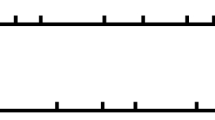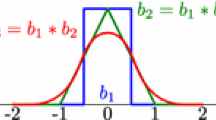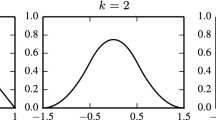Abstract
In this paper, we introduce a new position-dependent smoothness-increasing accuracy-conserving (SIAC) filter that retains the benefits of position dependence as proposed in van Slingerland et al. (SIAM J Sci Comput 33:802–825, 2011) while ameliorating some of its shortcomings. As in the previous position-dependent filter, our new filter can be applied near domain boundaries, near a discontinuity in the solution, or at the interface of different mesh sizes; and as before, in general, it numerically enhances the accuracy and increases the smoothness of approximations obtained using the discontinuous Galerkin (dG) method. However, the previously proposed position-dependent one-sided filter had two significant disadvantages: (1) increased computational cost (in terms of function evaluations), brought about by the use of \(4k+1\) central B-splines near a boundary (leading to increased kernel support) and (2) increased numerical conditioning issues that necessitated the use of quadruple precision for polynomial degrees of \(k\ge 3\) for the reported accuracy benefits to be realizable numerically. Our new filter addresses both of these issues—maintaining the same support size and with similar function evaluation characteristics as the symmetric filter in a way that has better numerical conditioning—making it, unlike its predecessor, amenable for GPU computing. Our new filter was conceived by revisiting the original error analysis for superconvergence of SIAC filters and by examining the role of the B-splines and their weights in the SIAC filtering kernel. We demonstrate, in the uniform mesh case, that our new filter is globally superconvergent for \(k=1\) and superconvergent in the interior (e.g., region excluding the boundary) for \(k\ge 2\). Furthermore, we present the first theoretical proof of superconvergence for postprocessing over smoothly varying meshes, and explain the accuracy-order conserving nature of this new filter when applied to certain non-uniform meshes cases. We provide numerical examples supporting our theoretical results and demonstrating that our new filter, in general, enhances the smoothness and accuracy of the solution. Numerical results are presented for solutions of both linear and nonlinear equations solved on both uniform and non-uniform one- and two-dimensional meshes.
















Similar content being viewed by others
Notes
Note that the notation used in the current manuscript is slightly different from the notation used in van Slingerland et al. [20]. Instead of using \(r_2=4k\) to denote the SRV filter we chose to use the number of B-splines directly for the clarity of the discussion.
References
Bramble, J.H., Schatz, A.H.: Higher order local accuracy by averaging in the finite element method. Math. Comput. 31, 94–111 (1977)
Cockburn, B.: Discontinuous Galerkin Methods for Convection-Dominated Problems, High-Order Methods for Computational Physics, vol. 9 of Lecture Notes in Computational Science and Engineering. Springer, New York (1999)
Cockburn, B., Hou, S., Shu, C.-W.: The Runge–Kutta local projection discontinuous Galerkin finite element method for conservation laws IV: the multidimensional case. Math. Comput. 54, 545–581 (1990)
Cockburn, B., Lin, S.-Y., Shu, C.-W.: TVB Runge–Kutta local projection discontinuous Galerkin finite element method for conservation laws II: one dimensional systems. J. Comput. Phys. 84, 90–113 (1989)
Cockburn, B., Luskin, M., Shu, C.-W., Süli, E.: Enhanced accuracy by post-processing for finite element methods for hyperbolic equations. Math. Comput. 72, 577–606 (2003)
Curtis, S., Kirby, R.M., Ryan, J.K., Shu, C.-W.: Post-processing for the discontinuous Galerkin method over nonuniform meshes. SIAM J. Sci. Comput. 30, 272–289 (2007)
de Boor, C.: A Practical Guide to Splines, Revised Edition. Springer, New York (2001)
Ji, L., van Slingerland, P., Ryan, J.K., Vuik, C.: Superconvergent error estimates for a position-dependent smoothness-increasing accuracy-conserving filter for dG solutions. Math. Comput. 84, 2239–2262 (2014)
King, James, Mirzaee, Hanieh, Ryan, J.K., Kirby, R.M.: Smoothness-increasing accuracy-conserving (SIAC) filtering for discontinuous Galerkin Solutions: improved errors versus higher-order accuracy. J. Sci. Comput. 53, 129–149 (2012)
Mirzaee, H., Ryan, J.K., Kirby, R.M.: Quantification of errors introduced in the numerical approximation and implementation of smoothness-increasing accuracy-conserving (SIAC) filtering of discontinuous Galerkin (dG) fields. J. Sci. Comput. 45, 447–470 (2010)
Mirzaee, H., Ryan, J.K., Kirby, R.M.: Efficient implementation of smoothness-increasing accuracy-conserving filters for discontinuous Galerkin solutions. J. Sci. Comput. 52, 85–112 (2012)
Mock, M.S., Lax, P.D.: The computation of discontinuous solutions of linear hyperbolic equations. Comm. Pure Appl. Math. 31, 423–430 (1978)
Ryan, J.K.: Local Derivative Post-processing: Challenges for a Non-uniform Mesh, Report 10–18. Delft University of Technology, Delft, The Netherlands (2010)
Ryan, J.K., Cockburn, B.: Local derivative post-processing for the discontinuous Galerkin method. J. Comput. Phys. 228, 8642–8664 (2009)
Ryan, J.K., Shu, C.-W.: One-sided post-processing for the discontinuous Galerkin methods. Methods Appl. Anal. 10, 295–307 (2003)
Ryan, J.K., Shu, C.-W., Atkins, H.L.: Extension of a post-processing technique for the discontinuous Galerkin method for hyperbolic equations with application to an aeroacoustic problem. SIAM J. Sci. Comput. 26, 821–843 (2005)
Schumaker, L.: Spline Functions: Basic Theory, 3rd edn. Cambridge University Press, Cambridge (2007)
Steffan, M., Curtis, S., Kirby, R.M., Ryan, J.K.: Investigation of smoothness enhancing accuracy-conserving filters for improving streamline integration through discontinuous fields. IEEE Trans. Vis. Comput. Graph. 14, 680–692 (2008)
Thomée, V.: High order local approximations to derivatives in the finite element method. Math. Comput. 31, 652–660 (1977)
van Slingerland, P., Ryan, J.K., Vuik, C.: Position-dependent smoothness-increasing accuracy-conserving (SIAC) filtering for accuracy for improving discontinuous Galerkin solutions. SIAM J. Sci. Comput. 33, 802–825 (2011)
Acknowledgments
We would like to first thank Dr. Mahsa Mirzargar for helping us drive this draft to completion. Without her help, we would have possibly never finished this manuscript. We would like to thank Dr. Hanieh Mirzaee for her discovery and discussion concerning the conditioning issues of the SRV filter. The first and second authors are sponsored by the Air Force Office of Scientific Research (AFOSR), Air Force Material Command, USAF, under Grant No. and FA8655-13-1-3017. The third author is sponsored in part by the Air Force Office of Scientific Research (AFOSR), Computational Mathematics Program (Program Manager: Dr. Fariba Fahroo), under Grant No. FA9550-12-1-0428. The U.S Government is authorized to reproduce and distribute reprints for Governmental purposes notwithstanding any copyright notation thereon.
Author information
Authors and Affiliations
Corresponding author
Additional information
Jennifer K. Ryan, Xiaozhou Li: Supported by the Air Force Office of Scientific Research (AFOSR), Air Force Material Command, USAF, under Grant No. FA8655-13-1-3017.
Robert M. Kirby: Supported by the Air Force Office of Scientific Research (AFOSR), Computational Mathematics Program (Program Manager: Dr. Fariba Fahroo), under Grant No. FA9550-08-1-0156.
Rights and permissions
About this article
Cite this article
Ryan, J.K., Li, X., Kirby, R.M. et al. One-Sided Position-Dependent Smoothness-Increasing Accuracy-Conserving (SIAC) Filtering Over Uniform and Non-uniform Meshes. J Sci Comput 64, 773–817 (2015). https://doi.org/10.1007/s10915-014-9946-6
Received:
Revised:
Accepted:
Published:
Issue Date:
DOI: https://doi.org/10.1007/s10915-014-9946-6




